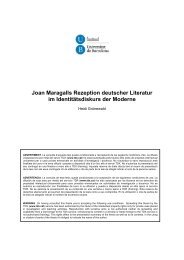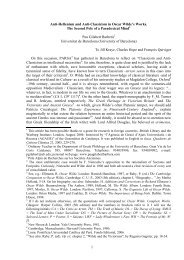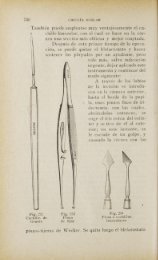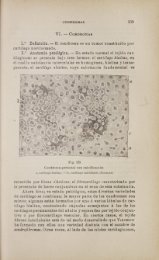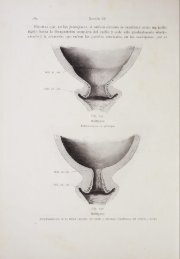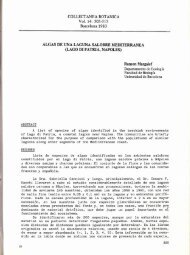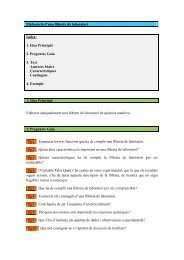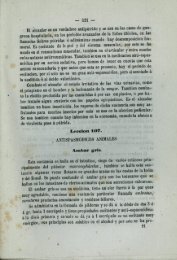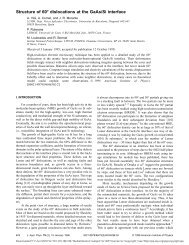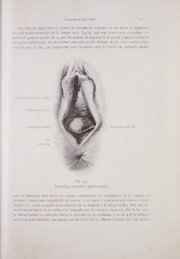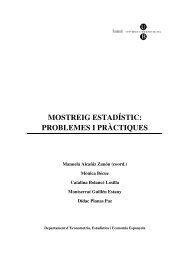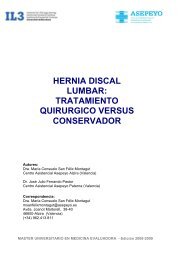The univalent Bloch-Landau constant, harmonic symmetry and ...
The univalent Bloch-Landau constant, harmonic symmetry and ...
The univalent Bloch-Landau constant, harmonic symmetry and ...
You also want an ePaper? Increase the reach of your titles
YUMPU automatically turns print PDFs into web optimized ePapers that Google loves.
<strong>The</strong> <strong>univalent</strong> <strong>Bloch</strong>-<strong>L<strong>and</strong>au</strong> <strong>constant</strong>,<br />
<strong>harmonic</strong> <strong>symmetry</strong> <strong>and</strong> conformal glueing<br />
Tom Carroll a,∗ , Joaquim Ortega-Cerdà b<br />
a Department of Mathematics, National University of Irel<strong>and</strong>, Cork, Irel<strong>and</strong>.<br />
b<br />
Departament de Matemàtica Aplicada i Anàlisi, Universitat de Barcelona,<br />
Gran Via 585, 08007 Barcelona, Spain.<br />
Abstract<br />
By modifying a domain first suggested by Ruth Goodman in 1935 <strong>and</strong><br />
by exploiting the explicit solution by Fedorov of the Polyá-Chebotarev<br />
problem in the case of four symmetrically placed points, an improved<br />
upper bound for the <strong>univalent</strong> <strong>Bloch</strong>-<strong>L<strong>and</strong>au</strong><strong>constant</strong> is obtained. <strong>The</strong><br />
domain that leads to this improved bound takes the formof a disk from<br />
which some arcs are removed in such a way that the resulting simply<br />
connected domain is <strong>harmonic</strong>ally symmetric in each arc with respect<br />
to the origin. <strong>The</strong> existence of domains of this type is established,<br />
using techniques from conformal welding, <strong>and</strong> some general properties<br />
of <strong>harmonic</strong>ally symmetric arcs in this setting are established.<br />
Résumé<br />
En modifiant un domaine suggéré par Ruth Goodman en 1935 et utilisant<br />
la solutionexplicite deFedorovduproblème dePolyá-Chebotarev<br />
pourquatrepointssymétriques, onarriveatrouverunebornesupérieure<br />
ameliorée pour la <strong>constant</strong>e de <strong>Bloch</strong>-<strong>L<strong>and</strong>au</strong> <strong>univalent</strong>e. Le domaine<br />
que porte a cette borne ameliorée a la forme d’un disque avec quelques<br />
arcsenlevésdetelfaçonqueledomainesimplement connexequerésulte<br />
est harmonique-symétric par rapport a l’origine. L’existence des domaines<br />
de cette type est établie en utilisant des techniques de soudage<br />
conforme et on prouve quelques propriétés des arcs symétriques dans<br />
cet contexte.<br />
Keywords: Univalent <strong>Bloch</strong>-<strong>L<strong>and</strong>au</strong> <strong>constant</strong>; Conformal welding;<br />
Harmonic <strong>symmetry</strong>.<br />
* Corresponding author<br />
E-mail addresses: t.carroll@ucc.ie (T. Carroll),<br />
jortega@ub.edu (J. Ortega-Cerdà).
1. <strong>The</strong> <strong>univalent</strong> <strong>Bloch</strong>-<strong>L<strong>and</strong>au</strong> <strong>constant</strong> <strong>and</strong> <strong>harmonic</strong><br />
<strong>symmetry</strong>.<br />
We write R D for the supremum radius of all disks contained in a<br />
planar domain D, this geometric quantity is called the inradius of the<br />
domain. We write D for the disk with centre zero <strong>and</strong> radius one in<br />
the complex plane.<br />
Let us suppose that f is a <strong>univalent</strong> map of the unit disk D. <strong>The</strong>re<br />
is a number U, independent of f, such that<br />
(1.1) R f(D) ≥ U|f ′ (0)|.<br />
Thus the image of the unit disk under any <strong>univalent</strong> map f of D<br />
contains some disk of every radius less than U|f ′ (0)|. <strong>The</strong> number<br />
U, known as the <strong>univalent</strong> or schlicht <strong>Bloch</strong>-<strong>L<strong>and</strong>au</strong> <strong>constant</strong>, is the<br />
largest number for which (1.1) holds, in that if U > U then there is<br />
a conformal mapping f of the unit disk for which f(D) contains no<br />
disk of radius U|f ′ (0)|. This <strong>constant</strong> was introduced in 1929 by <strong>L<strong>and</strong>au</strong><br />
[14], following on from <strong>Bloch</strong>’s famous paper [6] of a few years<br />
earlier. It is a consequence of the Koebe one-quarter theorem that<br />
U ≥ 1/4. <strong>L<strong>and</strong>au</strong> himself proved U > 0.566 in [14]. Over time, Laudau’s<br />
estimate for U was improved by Reich [17] (U > 0.569), Jenkins<br />
[11] (U > 0.5705), Toppila [20] (U > 0.5708), Zhang [22] <strong>and</strong> Jenkins<br />
[13] (U > 0.57088). Most recently, Xiong [21] has proved that<br />
U > 0.570884. Over the years, several domains have been put forward<br />
that provide upper bounds for U, among them those of Robinson [18]<br />
(U < 0.658) in 1935, Goodman [9] (U < 0.65647) in 1945 <strong>and</strong>, most<br />
recently, Beller <strong>and</strong> Hummel [3] (U < 0.6564155) in 1985. Our first<br />
result is an improved upper bound for U.<br />
<strong>The</strong>orem 1. <strong>The</strong>re is a simply connected domain D 0 that has inradius<br />
1, <strong>and</strong> a conformal map f of the unit disk D onto D 0 for which<br />
U ≤ 1<br />
|f ′ (0)| ≤ 0.6563937.<br />
<strong>The</strong> significance of this result is not so much the numerical improvement<br />
in the upper bound for U, but rather the shape of the domain<br />
that produced it, which is shown in Figure 1.<br />
We may write<br />
{ }<br />
Rf(D)<br />
(1.2) U = inf<br />
|f ′ (0)| : f is <strong>univalent</strong> in D <strong>and</strong> f(0) = 0 .<br />
This infimum is attained. If f is <strong>univalent</strong> in D with f(0) = 0, f ′ (0) =<br />
1, <strong>and</strong>if R f(D) = U, then f is a <strong>Bloch</strong> functionof the third kind <strong>and</strong>the<br />
domain D = f(D) is said to be an extremal domain for the inequality<br />
(1.1). A proof that extremal domains exist was first written down<br />
explicitly by Robinson [19]. Jenkins [13] has proved that an extremal<br />
domain must contain an extremal disk, that is, a disk of radius U. In<br />
1
2<br />
Figure 1. <strong>The</strong> domain D 0 <strong>and</strong> the extremal disks<br />
[12], Jenkins described a condition that any extremal domain for the<br />
<strong>univalent</strong> <strong>Bloch</strong>-<strong>L<strong>and</strong>au</strong> inequality (1.1) must satisfy. This condition<br />
was extended by the first author in [7]. In order to describe this more<br />
general condition, we need the notion of <strong>harmonic</strong> <strong>symmetry</strong>.<br />
A simple C 1 arc γ is said to be an internal boundary arc for a domain<br />
D if γ is part of the boundary of D <strong>and</strong> if, to each non-endpoint ζ of<br />
γ, there corresponds a positive ǫ such that the disk with centre ζ <strong>and</strong><br />
radius ǫ is part of D ∪ γ. In the case that D is simply connected,<br />
each non-endpoint ζ of the arc γ corresponds to two prime ends of D<br />
<strong>and</strong> each has a Poisson kernel associated with it, which we denote by<br />
P 1 (ζ,z) <strong>and</strong> P 2 (ζ,z). We say that D is <strong>harmonic</strong>ally symmetric in γ<br />
with respect to z 0 if<br />
P 1 (ζ,z 0 ) = P 2 (ζ,z 0 ) whenever ζ is a non-endpoint of γ.<br />
For example, if D = D\γ then D is <strong>harmonic</strong>ally symmetric in the arc<br />
γ with respect to 0 if <strong>and</strong> only if γ = [r,1] for some r in (0,1), up to<br />
rotation. More generally, if γ is an internal boundary arc for D <strong>and</strong> if<br />
also D∪γ is simply connected then D is <strong>harmonic</strong>ally symmetric in γ<br />
with respect to z 0 if <strong>and</strong> only if γ is in a geodesic arc through z 0 in the<br />
hyperbolic metric for D∪γ. This can be seen by conformally mapping<br />
D ∪γ onto D so that z 0 corresponds to 0 <strong>and</strong> γ corresponds to an arc<br />
˜γ, <strong>and</strong> then using the conformal invariance of the Possion kernel to<br />
conclude that D\ ˜γ is <strong>harmonic</strong>ally symmetric in ˜γ with respect to 0.<br />
<strong>The</strong> extension of Jenkins’ condition in [7] shows that there is a close<br />
relationship between the <strong>univalent</strong> <strong>Bloch</strong>-<strong>L<strong>and</strong>au</strong> <strong>constant</strong> <strong>and</strong> <strong>harmonic</strong><br />
<strong>symmetry</strong>.<br />
<strong>The</strong>orem. Suppose that D is an extremal domain for the <strong>univalent</strong><br />
<strong>Bloch</strong>-<strong>L<strong>and</strong>au</strong> <strong>constant</strong>. Suppose that γ is an internal boundary arc for<br />
D, no point of which lies on the boundary of an extremal disk. <strong>The</strong>n<br />
D is <strong>harmonic</strong>ally symmetric in γ with respect to 0.
<strong>The</strong> domains that were constructed in [18, 9, 3] in order to obtain<br />
upper bounds for U are essentially disks with radial slits removed. <strong>The</strong><br />
above extremality condition suggests how the domains in [18, 9, 3]<br />
might be modified so as to make them closer to being extremal, <strong>and</strong> in<br />
turn leads to <strong>The</strong>orem 1.<br />
Harmonic <strong>symmetry</strong> arises in connection with problems other than<br />
the determination of extremal domains for the <strong>univalent</strong> <strong>Bloch</strong>-<strong>L<strong>and</strong>au</strong><br />
inequality. It previously appeared in the work of Betsakos [4, Proposition<br />
2.1] in relation to another extremal problem, that of maximizing<br />
|f ′ (0)| over the family of all conformal maps f of the unit disk, with<br />
f(0) = 0, onto simply connected subdomains of the unit disk whose<br />
complement must contain some specified points. But the idea goes<br />
back much further than this, to Lavrentiev [15] <strong>and</strong> Grötzsch [10], in<br />
the context of the Pólya-Chebotarev problem [16] that consists in determining<br />
the continuum that has minimal capacity <strong>and</strong> that contains<br />
a given finite set of points in C. In Lavrentiev’s formulation of <strong>harmonic</strong><br />
<strong>symmetry</strong>, the preimage of each subarc of an internal boundary<br />
arc of the simply connected domain D, under a conformal map of the<br />
disk onto D under which 0 corresponds to z 0 in D, will comprise of<br />
two arcs of equal length on the unit circle. Thus the two ‘sides’ of each<br />
subarc of the internal boundary arc have the same <strong>harmonic</strong> measure<br />
at z 0 . This is also the formulation adopted in [7].<br />
In our second main result we study domains formed when the disk is<br />
slit along simple arcs in such a way that the resulting domain is simply<br />
connected <strong>and</strong> is <strong>harmonic</strong>ally symmetric in each arc with respect to<br />
0. We show that the <strong>harmonic</strong> measure of each arc may be specified,<br />
together with the <strong>harmonic</strong> measure between the endpoints of the arcs<br />
on the unit circle. To be precise, we consider families Γ consisting of a<br />
finite number of simple arcs that do not intersect, do not pass through<br />
the origin, <strong>and</strong> lie inside the unit disk D except for one endpoint of<br />
each arc that lies instead on the unit circle. For the purposes of this<br />
paper, we call such a family of arcs ‘admissible’. We associate with Γ<br />
the domain D(Γ) that is the complement of the traces of the arcs in<br />
the family, so that D(Γ) is a simply connected domain containing 0.<br />
Our second result concerns the problems of existence <strong>and</strong> uniqueness<br />
in this context. Together with a conformal mapping of the unit disk, it<br />
can be used to introduce <strong>harmonic</strong>ally symmetric slits in more general<br />
simply connected domains.<br />
<strong>The</strong>orem 2. Suppose that n positive numbers a 1 , a 2 , ..., a n <strong>and</strong> n<br />
non-negative numbers b 1 , b 2 , ..., b n are specified with<br />
3<br />
n∑<br />
a k < 1 <strong>and</strong><br />
k=1<br />
n∑ n∑<br />
a k + b k = 1.<br />
k=1 k=1
4<br />
<strong>The</strong>re is an admissible family of real analytic arcs Γ = {γ 1 ,γ 2 ,...,γ n }<br />
such that<br />
(T2.1) each arc γ k has <strong>harmonic</strong> measure a k at 0 with respect to D(Γ),<br />
(T2.2) the domain D(Γ) is <strong>harmonic</strong>ally symmetric in each arc γ k with<br />
respect to 0,<br />
(T2.3) the endpoints of the arcs on the unit circle, which we denote<br />
by ζ 1 , ζ 2 , ..., ζ n , respectively, are in anticlockwise order <strong>and</strong>,<br />
moreover, the <strong>harmonic</strong> measure at 0 <strong>and</strong> with respect to D(Γ)<br />
of the anticlockwise arc of the unit circle from ζ k to ζ k+1 is b k<br />
for k = 1, 2, ..., n−1.<br />
This configuration is unique up to rotation.<br />
<strong>The</strong> plan of the paper is as follows. We briefly describe Goodman’s<br />
domain <strong>and</strong> its modification by Beller <strong>and</strong> Hummel in the next section.<br />
In Section 3, we construct the domain D 0 <strong>and</strong> prove <strong>The</strong>orem 1. In<br />
order to do so, we use an explicit solution by Fedorov of the Pólya-<br />
Chebotarev problem in the case of four symmetrically placed points.<br />
<strong>The</strong>orem 2 is proved in Section 4, using techniques drawn from conformal<br />
welding. Related results on <strong>harmonic</strong> <strong>symmetry</strong> are also established<br />
in this section.<br />
2. Goodman’s domain <strong>and</strong> the Beller-Hummel domain<br />
Ruth Goodman’s domain [9] is constructed in stages. <strong>The</strong> first stage<br />
consists of the removal from the plane of three radial halflines that<br />
start from the cube roots of unity. <strong>The</strong> second stage consists of the<br />
removal of three further radial halflines starting from two times the<br />
cube roots of −1. <strong>The</strong> domain G 2 formed by the plane minus these six<br />
halflines is shown in Figure 2. Goodman continues the construction by,<br />
ateachstage,removingradialhalflinesthatbisectthesectorsformedby<br />
previousgenerationsofhalflinesinsuchawayastomaintaininradius1.<br />
<strong>The</strong> circle C 1 with unit radius <strong>and</strong> with centre P 1 = (c,1), where<br />
c = 1+ √ 2 √ 3−3, is tangent to the halfline [1,∞] <strong>and</strong> passes through<br />
the tip 2e iπ/3 of the halfline above it. Thus the boundary of Goodman’s<br />
domain includes a halfline with argument π/6 <strong>and</strong> one endpoint on<br />
C 1 , together with the successive rotations of this halfline through an<br />
angle π/3. <strong>The</strong> modification of the Goodman domain constructed by<br />
Beller <strong>and</strong> Hummel [3] to obtain their upper bound for U agrees with<br />
Goodman’s domain up to the second generation of halflines – indeed,<br />
it is difficult to imagine (but apparently equally difficult to prove) that<br />
the construction of an extremal domain might begin any differently.<br />
<strong>The</strong>ir improved estimate was motivated by the observation that the<br />
circle C 1 in Figure 2 sneaks slightly around the end of the halfline<br />
with angle π/3 so that its centre does not have argument π/6. This<br />
led them to vary the angles of the third generation of halfline slits<br />
in Goodman’s domain to find an optimal configuration of this type.
5<br />
2e πi/3<br />
−2<br />
e 2πi/3<br />
C 1<br />
P 1 (c,1)<br />
0 1<br />
2e −πi/3<br />
e −2πi/3<br />
Figure 2. <strong>The</strong> first two stages of Goodman’s domain<br />
In their configuration, the third generation of slits are far from being<br />
bisectors of the six sectors in the domain G 2 .<br />
3. An improved upper bound for the <strong>univalent</strong><br />
<strong>Bloch</strong>-<strong>L<strong>and</strong>au</strong> <strong>constant</strong><br />
All authors, who either put forward a putative extremal domain for<br />
the<strong>Bloch</strong>-<strong>L<strong>and</strong>au</strong><strong>constant</strong> orwhoseek anumerical upperboundforU,<br />
start from the six-slit plane G 2 , as described in Section 2, <strong>and</strong> proceed<br />
by inserting further radial halflines to divide the sectors as they widen<br />
with the aim of preserving the inradius. It is necessary to truncate<br />
at some point when seeking an upper bound, which we do. It is now<br />
clear from [7] (see also the concluding remark in [2]) that any new<br />
boundary arcs need to be inserted in such a way that the final domain<br />
is <strong>harmonic</strong>ally symmetric in each arc. It is not clear that this can be<br />
achieved in an iterative manner, in that the insertion of later boundary<br />
arcs may destroy the <strong>harmonic</strong> <strong>symmetry</strong> of earlier arcs. Nevertheless,<br />
at least from a computational point of view, it is natural to begin with<br />
the domain G 2 <strong>and</strong> to insert six extra arcs to obtain a domain that is<br />
<strong>harmonic</strong>ally symmetric in each new arc with respect to 0 <strong>and</strong> remains<br />
symmetric under reflection, <strong>and</strong> therefore <strong>harmonic</strong>ally symmetric, in<br />
each of the original six halflines that form the boundary of the domain<br />
G 2 . <strong>The</strong> domain we construct is of the type shown in Figure 5. To<br />
perform the necessary calculations, we exploit the connection between
6<br />
<strong>harmonic</strong> <strong>symmetry</strong> <strong>and</strong> the Pólya-Chebotarev problem, in particular<br />
results of Fedorov [8].<br />
3.1. Fedorov’s results on certain configurations of minimal capacity.<br />
Given α <strong>and</strong> c such that 0 < α ≤ π/2 <strong>and</strong> 0 < c < 2cosα, Fedorov<br />
finds the continuum E(α,c) with minimal capacity that contains<br />
each of the points0, c, e iα <strong>and</strong>e −iα . <strong>The</strong> typical extremal configuration<br />
is shown in Figure 3. <strong>The</strong> point b is determined explicitly by Fedorov<br />
e iα<br />
b<br />
0 c<br />
e −iα<br />
Figure 3. Fedorov’s continuum of minimal capacity<br />
containing four specified points: 0, e iα , e −iα <strong>and</strong> c.<br />
in terms of c <strong>and</strong> α. Moreover the capacity of the extremal compact<br />
set is<br />
(3.1) cap ( E(α,c) ) = (1+p)2 Θ 2 (0)<br />
.<br />
4cΘ 2 (w)<br />
Here Θ is the Jacobi <strong>The</strong>ta function [1, p. 577],<br />
p = √ 1−2ccosα+c 2 ,<br />
( ( ) ) 1−p<br />
w = F arccos ;k<br />
1+p<br />
where √ p+1−ccosα<br />
k =<br />
2p<br />
<strong>and</strong> the function F is an incomplete elliptic integral of the first kind,<br />
that is ∫ x<br />
dt<br />
F(x;k) =<br />
(1−t 2 )(1−k 2 t 2 ) .<br />
0<br />
3.2. <strong>The</strong> required conformal mapping. <strong>The</strong>mapping functionhof<br />
the complement of a compact set E onto the complement of the closed<br />
unit disk may be exp<strong>and</strong>ed as<br />
z<br />
(3.2) h(z) = +O(1), as z → ∞,<br />
cap(E)<br />
up to rotation. This provides a link between the problem solved by<br />
Fedorov <strong>and</strong> the example that will yield an improved upper bound for<br />
the <strong>Bloch</strong>-<strong>L<strong>and</strong>au</strong> <strong>constant</strong>, in that minimising the capacity of the set<br />
therefore corresponds to maximising the derivative of the mapping h at<br />
infinity. Moreover, following the argument in [7], the arcs making up<br />
,
the extremal configuration will be <strong>harmonic</strong>ally symmetric at infinity.<br />
As noted in the introduction, this latter observation was first made by<br />
Lavrentiev [15].<br />
Wework withdomains Ω = Ω z0 ,R asshown inFigure4, where R > 3,<br />
|z 0 | < R 3 , <strong>and</strong> the arc γ z0 is chosen so that Ω z0 ,R is <strong>harmonic</strong>ally<br />
symmetric in γ z0 with respect to 0. If g is a conformal map of the unit<br />
7<br />
γ z0<br />
Ω z0 ,R z 0<br />
−8 1<br />
z 0<br />
R 3<br />
γ z0<br />
Figure 4. A domain Ω z0 ,R<br />
disk D onto such a domain Ω z0 ,R, with g(0) = 0, then f(z) = z 3 √<br />
g(z 3 )<br />
z 3<br />
is a conformal map of D onto a domain U w,R as shown in Figure 5.<br />
<strong>The</strong> arcs that appear are all <strong>harmonic</strong>ally symmetric, <strong>and</strong> thus the<br />
w<br />
U w,R<br />
−2 1<br />
R<br />
w<br />
Figure 5. A domain U w,R<br />
conformal mapping of the unit disk onto U w,R is a good c<strong>and</strong>idate for<br />
having a relatively large derivative at the origin. This derivative is<br />
|f ′ (0)| = 3√ |g ′ (0)|. In order that this provide a useful estimate of the<br />
<strong>Bloch</strong>-<strong>L<strong>and</strong>au</strong> <strong>constant</strong>, we need to arrange for U w,R to have inradius<br />
1. We leave this aside for the moment <strong>and</strong> show how to use Fedorov’s<br />
results on capacity to compute |f ′ (0)| for given z 0 <strong>and</strong> R. We write<br />
k for the Koebe mapping k(z) = z/(1 −z) 2 of the unit disk onto the<br />
plane slit along the negative real axis from minus infinity to −1/4.
8<br />
Proposition 1. We write f for a conformal map of the unit disk D<br />
onto U w,R for which f(0) = 0. <strong>The</strong>n, with z 0 = w 3 ,<br />
(3.3) |f ′ (0)| = 1 3<br />
√|ψ(z 0 )−ψ(1)|cap ( E(α,c) )<br />
R<br />
where<br />
1<br />
(3.4) ψ(z) = −<br />
k(z/R 3 )<br />
<strong>and</strong><br />
(3.5) e iα = ψ(z 0)−ψ(1)<br />
|ψ(z 0 )−ψ(1)| ,<br />
Proof. <strong>The</strong> map<br />
(3.6) φ(z) = ψ(z)−ψ(1)<br />
|ψ(z 0 )−ψ(1)| ,<br />
c = ψ(−8)−ψ(1)<br />
|ψ(z 0 )−ψ(1)| .<br />
where ψ isgiven by (3.4), maps Ω z0 ,R ontothe complement of Fedorov’s<br />
continuum E(α,c) with α <strong>and</strong> c given by (3.5). <strong>The</strong> <strong>harmonic</strong> <strong>symmetry</strong><br />
of arcs is preserved because each mapping extends continuously<br />
to all internal boundary arcs <strong>and</strong> because the domains involved are<br />
all symmetric with respect to the real axis. If h is the mapping of the<br />
complement of E(α,c) onto the complement of the unit disk mentioned<br />
in (3.2), then a suitable mapping g of Ω z0 ,R onto the unit disk, with<br />
g(0) = 0, is given by<br />
(3.7) g(z) =<br />
1<br />
h ( φ(z) ).<br />
Now g ′ (0) can be computed explicitly, in terms of z 0 , R <strong>and</strong> h ′ (∞), for<br />
example by computing the power series for g. One obtains<br />
(3.8) |g ′ (0)| = |ψ(z 0)−ψ(1)|<br />
.<br />
R 3 h ′ (∞)<br />
<strong>The</strong> value of h ′ (∞) is 1/cap ( E(α,c) ) <strong>and</strong> is given explicitly, in its turn,<br />
by Fedorov’s result (3.1).<br />
□<br />
3.3. <strong>The</strong> choice of w <strong>and</strong> R. We know how to build, for any w <strong>and</strong><br />
R, a conformal map f of the unit disk onto U w,R <strong>and</strong> have a formula<br />
for its derivative at 0. In order that this provide an upper bound for<br />
the <strong>univalent</strong> <strong>Bloch</strong>-<strong>L<strong>and</strong>au</strong> <strong>constant</strong>, we must choose w <strong>and</strong> R in such<br />
a way that<br />
• <strong>The</strong> domain U w,R has inradius one,<br />
• <strong>The</strong> derivative |f ′ (0)| is as big as possible.<br />
Proposition 2. We suppose that R is fixed with 3 < R < 4.5. We set<br />
(3.9) P 2 = (R−1)e i(π 3 −α) where α = arcsin [ 1/(R−1) ] ,
<strong>and</strong> write d = |P 2 − P 1 |, where P 1 is as in Section 2. We set θ =<br />
arccos(d/2) <strong>and</strong> set<br />
(3.10) w = P 1 + 1 d e−iθ( P 2 −P 1<br />
)<br />
.<br />
<strong>The</strong>n U w,R has inradius one.<br />
9<br />
C 2<br />
P 2<br />
2e iπ/3 w<br />
θ<br />
C 1 P 1<br />
C 3<br />
1<br />
R<br />
Figure 6. <strong>The</strong> choice of the point w in Proposition 2.<br />
Proof. <strong>The</strong>circleC 1 isthesameasthatshown inFigure2: ithascentre<br />
(c,1),wherec = 1+ √ 2 √ 3−3,hasunitradius<strong>and</strong>istangenttotheslit<br />
[1,R] <strong>and</strong> passes through the tip 2e iπ/3 of the slit above it. <strong>The</strong> circle<br />
C 2 with centre P 2 , as specified in (3.9), <strong>and</strong> of unit radius is tangent<br />
to the circle |z| = R <strong>and</strong> tangent to the halfline of argument π/3. It<br />
is elementary to check that if R ≤ 4.5 then d = |P 2 −P 1 | < 2, so that<br />
these two circles meet, as in Figure 6. <strong>The</strong> position of the intersection<br />
point w can be computed explicitly, which results in (3.10).<br />
LetC 3 bethecircle ofunit radiusthat istangent tothe circle|z| = R<br />
<strong>and</strong> also tangent to the line segment [1,R]. Considering that w lies on<br />
its boundary, the domain U w,R will have inradius 1 if the circle C 3<br />
contains the point w (the position of the <strong>harmonic</strong>ally symmetric arc<br />
through w being irrelevant to this consideration). In fact the circles C 2<br />
<strong>and</strong> C 3 meet at points on the halfline with argument π/6. Thus w lies<br />
inside the circle C 3 if it has argument less than π/6: it is elementary<br />
to check that this is the case if R ≤ 4.5.<br />
□<br />
Proof of <strong>The</strong>orem 1. With the choice R = 4.0546358 in Proposition 2,<br />
it is then the case that U w,R has inradius 1 <strong>and</strong> Proposition 1 can<br />
be used to compute the derivative of the conformal map f of the<br />
unit disk D onto U w,R for which f(0) = 0. This leads to the value<br />
0.65639361315219, correct to 10 decimal places, for this derivative,<br />
which proves <strong>The</strong>orem 1.
10<br />
For the actual picture of the domain, shown below in Figure 1, one<br />
has to draw Fedorov’s domain <strong>and</strong> transport it to U w,R with the inverse<br />
of the map φ given in (3.6). <strong>The</strong> key point for drawing the domain is to<br />
compute the curvilinear arc of E(α,c). <strong>The</strong> point b is given explicitly<br />
by Fedorov [8, Formula 6]:<br />
b(α,c) = √ p Θ′ (w)<br />
Θ(w) + c<br />
p+1 .<br />
<strong>The</strong> quotient Θ ′ (w)/Θ(w) is the Jacobi Zeta function <strong>and</strong> can be computed<br />
numerically (see Abramovitz <strong>and</strong> Stegun, [1, p. 578]). To determine<br />
the arcs that grow from b to e iα one integrates the quadratic<br />
differential equation z ′ (t) 2 Q(z(t)) = 1, where<br />
Q(z) =<br />
(z −b) 2<br />
z(z −c)(z 2 −2zcosα+1) ,<br />
[8, Formula 5] – we point out for the reader’s convenience that there<br />
is a typograhic error in the referenced formula in that the term z 2 −<br />
2ccosα+1 in the denominator of the quadratic differential should read<br />
z 2 −2zcosα+1: Fedorov’s Formula (14) for Q is correct. □<br />
4. Harmonic <strong>symmetry</strong> <strong>and</strong> conformal glueing<br />
4.1. Proof of <strong>The</strong>orem 2. We first prove the existence of a family<br />
of arcs with the required properties, <strong>and</strong> postpone a proof of the<br />
uniqueness statement. We begin by assuming that each b k is strictly<br />
positive.<br />
We divide the unit circle into 2n arcs I 1 , J 1 , I 2 , J 2 , ..., I n , J n , in<br />
anti-clockwise order so that |I k | = 2πa k , |J k | = 2πb k , for 1 ≤ k ≤ n.<br />
We write φ k for the following involution; φ k : I k → I k so that ζ <strong>and</strong><br />
φ k (ζ) are at the same distance from the centre of I k , but lie on opposite<br />
sides of the centre. Our goal is to produce a conformal map f of D into<br />
D, continuous on the closure of D, that glues each of these involutions,<br />
in that<br />
(4.1) f(ζ) = f ( φ k (ζ) ) , ζ ∈ I k , 1 ≤ k ≤ n.<br />
We produce a quasiconformal glueing to begin with, <strong>and</strong> then correct<br />
this to a conformal glueing in a st<strong>and</strong>ard way (see, for example, [5,<br />
Remark 8]).<br />
We divide a second unit circle into 2n equal arcs Ĩ1, ˜J1 , Ĩ2, ˜J2 , ...,<br />
Ĩ n , ˜Jn , in anti-clockwise order. Next we construct a quasi-symmetric<br />
homeomorphism T of the first unit circle to the second unit circle such<br />
that T(I k ) = Ĩk, T(J k ) = ˜J k for each k <strong>and</strong> T is linear on each interval<br />
I k <strong>and</strong> J k . By the Beurling-Ahlfors Extension <strong>The</strong>orem, T may be<br />
extended to a quasiconformal map of D onto D, which we again call T,<br />
with T(0) = 0.
Next we write Γ 1 for the admissible family of arcs formed by the<br />
straight line segment ˜γ 1 = [r,1], together with is rotations ˜γ k+1 =<br />
e 2πki/n˜γ 1 , k = 1,2, ..., n−1,whererischosensothatω ( 0,˜γ 1 ;D(Γ 1 ) ) =<br />
1/(2n). We write g for the conformal map of D onto D(Γ 1 ) for which<br />
g(0) = 0 <strong>and</strong> g(Ĩk) = ˜γ k , for 1 ≤ k ≤ n. <strong>The</strong>n<br />
S = g ◦T<br />
is a quasiconformal map of the unit disk onto D(Γ 1 ). <strong>The</strong> map S<br />
extends continuously to the boundary of D. Tracing the boundary<br />
correspondence under the mappings T, <strong>and</strong> then g, shows that it is a<br />
quasiconformal glueing of the intervals I k , in that<br />
S(ζ) = S ( φ k (ζ) ) , ζ ∈ I k , 1 ≤ k ≤ n.<br />
By the Measurable Riemann Mapping <strong>The</strong>orem, we can now correct S<br />
to a conformal glueing by making a quasiconformal map R of D onto<br />
D for which R(0) = 0 <strong>and</strong><br />
f = R◦S<br />
is conformal. <strong>The</strong>n (4.1) holds. <strong>The</strong> arcs we are looking for are then<br />
γ k = R(˜γ k ), for 1 ≤ k ≤ n <strong>and</strong> Γ = {γ 1 ,γ 2 ,...,γ n }. Since f is<br />
conformal <strong>and</strong> f(0) = 0, it preserves <strong>harmonic</strong> measure at 0. Thus<br />
ω ( 0,γ k ;D(Γ) ) = ω ( 0,f −1 (γ k );D ) = ω ( 0,I k ;D) = a k .<br />
This is (T2.1). Moreover, since f is a conformal glueing on the interval<br />
I k , the domain D(Γ) is <strong>harmonic</strong>ally symmetric in γ k with respect to<br />
0, which is (T2.2). Finally, f maps each arc J k on the unit circle onto<br />
the anti-clockwise arc of the unit circle joining the endpoints ζ k of γ k<br />
<strong>and</strong> ζ k+1 of γ k+1 on the unit circle, so that (T2.3) follows. <strong>The</strong> fact<br />
that the arcs are real analytic comes from the control we have on the<br />
quasiconformality of the maps constructed.<br />
This construction depends continuously on the parameters a k <strong>and</strong><br />
b k . In the limit as one or more of the parameters b k approach zero, it<br />
leads to a configuration satisfying (T2.1), (T2.2) <strong>and</strong> (T2.3) in which<br />
two or more of the curves have a common endpoint on the unit circle.<br />
This covers the proof of existence in all cases in <strong>The</strong>orem 2.<br />
We now deal with the uniqueness of the configuration we have just<br />
now constructed. We suppose that Γ 1 = {γ1,γ 1 2,...,γ 1 n} 1 <strong>and</strong> Γ 2 =<br />
{γ1,γ 2 2,...,γ 2 n} 2 are sets of admissible arcs that satisfy (T2.1), (T2.2)<br />
<strong>and</strong> (T2.3) (with Γ replaced by Γ 1 <strong>and</strong> by Γ 2 as necessary). We assume<br />
thatthearcsinΓ 1 arerealanalytic, butthoseinΓ 2 neednotbe. Having<br />
set up the intervals I 1 to I n <strong>and</strong> J 1 to J n as in the proof of existence,<br />
we consider conformal mappings f 1 : D → D(Γ 1 ) <strong>and</strong> f 2 : D → D(Γ 2 )<br />
with f 1 (0) = 0, f 2 (0) = 0 <strong>and</strong> with f 1 (I k ) = γk 1, f 2(I k ) = γk 2, for<br />
each k between 1 <strong>and</strong> n. <strong>The</strong>n f = f 2 ◦f1 −1 is a conformal map from<br />
D(Γ 1 ) to D(Γ 2 ). Moreover, f extends continuously from D(Γ 1 ) to D<br />
because of the <strong>harmonic</strong> <strong>symmetry</strong>. By the regularity of the arcs in Γ 1 ,<br />
11
12<br />
Morera’s <strong>The</strong>orem is applicable <strong>and</strong> we may deduce that f extends to<br />
a conformal self map of the disk D with f(0) = 0. Hence f is a rotation<br />
<strong>and</strong> the uniqueness statement follows.<br />
4.2. A variation on <strong>The</strong>orem 2. We describe a version of <strong>The</strong>orem<br />
2 in which the <strong>harmonic</strong>ally symmetric arcs again have specified<br />
<strong>harmonic</strong> measures, but in which one specifies the lengths, rather than<br />
the <strong>harmonic</strong> measures, of the arcs on the unit circle that are formed<br />
by the endpoints ζ k of the arcs γ k . In other words, the position of the<br />
endpoints of the arcs γ k on the unit circle may be specified.<br />
<strong>The</strong>orem 3. Suppose that n positive numbers a 1 , a 2 , ..., a n , with<br />
∑ n<br />
k=1 a k < 1, <strong>and</strong> n points ζ 1 , ζ 2 , ..., ζ n in anticlockwise order on<br />
the unit circle, are specified. <strong>The</strong>n there is an admissible family of real<br />
analytic arcs Γ = {γ 1 ,γ 2 ,...,γ n } such that<br />
(T3.1) each arc γ k has <strong>harmonic</strong> measure a k at 0 with respect to D(Γ),<br />
(T3.2) the domain D(Γ) is <strong>harmonic</strong>ally symmetric in each arc γ k with<br />
respect to 0,<br />
(T3.3) the endpoint of γ k on the unit circle is ζ k , for each k.<br />
Proof. Wewritebfor1− ∑ n<br />
1 a k. Weconsider allpossible configurations<br />
in <strong>The</strong>orem 2 in which the numbers a 1 , a 2 , ..., a n are as specified <strong>and</strong><br />
the<br />
∑<br />
non-negative numbers b 1 , b 2 , ..., b n are allowed to vary subject to<br />
n<br />
1 b k = b. For a permissible choice of the parameters b k , k = 1, 2,<br />
..., n, we denote by x k the endpoint of the resulting arc γ k on the unit<br />
circle, <strong>and</strong> we write l k for the length of the anticlockwise arc of the unit<br />
circle between x k <strong>and</strong> x k+1 (with x n+1 = x 1 ). In this way, we have a<br />
map T from the simplex<br />
{<br />
}<br />
n∑<br />
Σ 1 = (b 1 ,b 2 ,...,b n ) : b k ≥ 0 <strong>and</strong> b k = b<br />
to the simplex<br />
Σ 2 =<br />
{<br />
(l 1 ,l 2 ,...,l n ) : l k ≥ 0 <strong>and</strong><br />
1<br />
}<br />
n∑<br />
l k = 2π<br />
given by T(b 1 ,b 2 ,...,b n ) = (l 1 ,l 2 ,...,l n ). <strong>The</strong> map T : Σ 1 → Σ 2 is<br />
continuous. It has the key property that l k is zero if <strong>and</strong> only if b k<br />
is zero, from this it follows that each vertex, edge, <strong>and</strong> i-face of Σ 1 is<br />
mapped into the corresponding vertex, edge, or i-face of Σ 2 . <strong>The</strong> proof<br />
will be complete once it is shown that the map T is onto Σ 2 , for then<br />
(T3.3) will hold after a rotation if l k is chosen to be the arc length<br />
between ζ k <strong>and</strong> ζ k+1 on the unit circle (with ζ n+1 = ζ 1 ).<br />
Let us first consider any two vertices of the simplex Σ 2 <strong>and</strong> the edge<br />
e joining them. <strong>The</strong> pre-images of these vertices under T are vertices of<br />
Σ 1 , <strong>and</strong> the image of the edge joining these vertices lies in the edge e.<br />
By continuity of the map, T is onto e. We can now proceed inductively.<br />
1
We consider an (i+1)-face f 1 of Σ 1 , the i-faces that bound it, <strong>and</strong> the<br />
corresponding (i + 1)-face f 2 of Σ 2 . Assuming that T maps each of<br />
these i-faces onto the corresponding i-face of Σ 2 , it follows fromthe key<br />
property of T that the image of the i-faces bounding f 1 has winding<br />
number 1(mod2) about each interior point of f 2 . Consequently, T is<br />
onto f 2 .<br />
□<br />
4.3. Harmonically symmetric arcs don’t grow. It is natural to<br />
ask whether the <strong>harmonic</strong>ally symmetric arcs γ k in <strong>The</strong>orem 3 can be<br />
described by means of a differential equation of Löwner type. As our<br />
final result, we show that this is not possible, even in the case of two<br />
<strong>harmonic</strong>ally symmetric arcs. We note that if the data in <strong>The</strong>orem 3<br />
is symmetric with respect to R, then, by construction, the resulting<br />
<strong>harmonic</strong>ally symmetric curves can be taken symmetric with respect<br />
to R.<br />
<strong>The</strong>orem 4. We suppose that ζ lies on the upper half of the unit circle<br />
<strong>and</strong> that a 1 <strong>and</strong> a 2 lie in (0,1) with a 1 < a 2 . <strong>The</strong>orem 3 is applied twice<br />
to construct two pairs of <strong>harmonic</strong>ally symmetric curves, {γ 1 ,γ 1 } <strong>and</strong><br />
{γ 2 ,γ 2 } respectively, the first from the data a 1 , a 1 , ζ, ζ, <strong>and</strong> the second<br />
from the data a 2 , a 2 , ζ, ζ. <strong>The</strong>n γ 1 ⊈ γ 2 except in the case when ζ = i.<br />
Proof. Let us suppose that γ 1 ⊆ γ 2 . Since D\{γ 1 ∪¯γ 1 } is <strong>harmonic</strong>ally<br />
symmetric in ¯γ 1 with respect to 0, ¯γ 1 is a geodesic arc in D\γ 1 . Since<br />
D\{γ 2 ∪¯γ 2 } is <strong>harmonic</strong>ally symmetric in ¯γ 2 with respect to 0, ¯γ 2 , <strong>and</strong><br />
hence its subarc ¯γ 1 , is a geodesic arc in D \γ 2 . Thus ¯γ 1 is a geodesic<br />
arc with respect to both the domain D\γ 1 <strong>and</strong> the domain D\γ 2 .<br />
We write Γ 1 for the full geodesic in D\γ 1 of which ¯γ 1 is a part <strong>and</strong><br />
write Γ 2 for the full geodesic in D\γ 2 of which ˜γ 1 is a part. Both Γ 1<br />
<strong>and</strong> Γ 2 pass through the origin. We map D\γ 1 onto the unit disk by<br />
a conformal map f 1 so that Γ 1 is mapped onto (−1,1) <strong>and</strong> map D\γ 2<br />
onto the unit disk by a conformal map f 2 so that Γ 2 is mapped onto<br />
(−1,1).<br />
We consider the map g = f 1 ◦ f2 −1 , which maps the unit disk into<br />
itself conformally. Moreover, g is real-valued on f 2 (¯γ 1 ), which itself is<br />
a subinterval of (−1,1). Thus g is real-valued on the entire interval<br />
(−1,1). Since f2 −1 (−1,1) = Γ 2 , it then follows that<br />
f 1 (Γ 2 ) ⊆ (−1,1) = f 1 (Γ 1 ),<br />
so that<br />
Γ 2 ⊆ Γ 1 .<br />
<strong>The</strong>re arenow two possible geometric situations to consider, depending<br />
on where the geodesic Γ 2 might end (both it <strong>and</strong> Γ 1 begin at the<br />
endpoint of ¯γ 1 on the unit circle). Suppose that Γ 2 were to end at a<br />
boundary point of D \ γ 1 . In this case, Γ 2 <strong>and</strong> Γ 1 coincide <strong>and</strong> the<br />
final step is to recall that the <strong>harmonic</strong> measure of the boundary is<br />
split evenly in two along a hyperbolic geodesic. Let E be that part of<br />
13
14<br />
the boundary of the domain D \ γ 2 that is bordered by the common<br />
endpoints of Γ 2 <strong>and</strong> Γ 1 <strong>and</strong> does not include γ 2 \γ 1 . At any point P<br />
on Γ 2 , for example 0, the <strong>harmonic</strong> measure of E at P with respect to<br />
D\γ 2 is 1/2 since Γ 2 is a hyperbolic geodesic for D\γ 2 . Since P lies<br />
on Γ 1 , which is a hyperbolic geodesic for D\γ 1 , E also has <strong>harmonic</strong><br />
measure 1/2 at P with respect to D\γ 1 . However, D\γ 1 contains D\γ<br />
strictly, so this is impossible. We conclude that the geodesic Γ 2 must<br />
end at a point of γ 2 \γ 1 .<br />
Under the map f 1 , the geodesic Γ 1 relative to the domain D\γ 1 is<br />
mapped onto the real axis in the unit disk <strong>and</strong> the domain D \ γ 2 is<br />
mapped to the domain<br />
Ω = D\[f 1 (γ 2 \γ 1 )].<br />
<strong>The</strong> arc f 1 (γ 2 \γ 1 ) begins on the unit circle <strong>and</strong> ends at an interior<br />
point ofthe unit disk. Moreover, f 1 (Γ 2 ) is a geodesic in Ω<strong>and</strong> is part of<br />
the real axis, <strong>and</strong> so Ω must be symmetric under reflection in the real<br />
axis. This forces f 1 (γ 2 \γ 1 ) to be part of the interval (−1,1). Pulling<br />
this picture back under f1 −1 , we find that<br />
Γ 1 = Γ 2 ∪(γ 2 \γ 1 ),<br />
so that the geodesic Γ 1 of D 1 = D\{γ 1 ∪ ¯γ 1 } is an arc that joins the<br />
endpoints of γ 1 <strong>and</strong> ¯γ 1 <strong>and</strong> that passes through 0. Since Γ 1 divides<br />
the boundary of D 1 into two, each of <strong>harmonic</strong> measure 1/2 at 0, <strong>and</strong><br />
the domain D 1 is also <strong>harmonic</strong>ally symmetric in both γ <strong>and</strong> ¯γ with<br />
respect to 0, it follows that the two arcs of the unit circle determined<br />
by ζ <strong>and</strong> ¯ζ have equal <strong>harmonic</strong> measure b 1 = (1 − a 1 )/2 at 0 with<br />
respect to D 1 . By the uniqueness statement in <strong>The</strong>orem 2, there is<br />
only one configuration (up to rotation) that realises the configuration<br />
in <strong>The</strong>orem 2 with n = 2 <strong>and</strong> symmetric data a 1 , a 1 , b 1 , b 1 <strong>and</strong> this<br />
configuration is the disk with the ends of a diameter removed. Since<br />
D 1 is symmetric in the real axis, we conclude that γ 1 lies along the<br />
imaginary axis.<br />
□<br />
References<br />
[1] Abramowitz, M. <strong>and</strong> I. Stegun: H<strong>and</strong>book of mathematical functions with<br />
formulas, graphs, <strong>and</strong> mathematical tables. National Bureau of St<strong>and</strong>ards Applied<br />
Mathematics Series, 55, (1964).<br />
[2] Bañuelos, R. <strong>and</strong> T. Carroll: Brownian motion <strong>and</strong> the fundamental frequency<br />
of a drum Duke Math. J. 75 no. 3, (1994) 575–602.Addendum 82 no. 1 (1996)<br />
227.<br />
[3] Beller, E. <strong>and</strong> J.A. Hummel: On the <strong>univalent</strong> <strong>Bloch</strong> <strong>constant</strong> Complex Variables<br />
<strong>The</strong>ory Appl. 4 no. 3 (1985) 243–252.<br />
[4] Betsakos, D.: On bounded <strong>univalent</strong> functions that omit two given values<br />
Colloquium Mathematicum 80 (1999) no. 2, 253–258.<br />
[5] Bishop, C. J.: Conformal welding <strong>and</strong> Koebe’s theorem Ann. of Math. (2) 166<br />
(2007), no. 3, 613–656.
[6] <strong>Bloch</strong>, A.: Les théorèmes de M. Valiron sur les fonctions entières et la théorie<br />
de l’uniformisation Ann. Fac. Sci. Univ. Toulouse 17 no. 3 (1925) 1–22.<br />
[7] Carroll, T.: An extension of Jenkins’ condition for extremal domains associated<br />
with the <strong>univalent</strong> <strong>Bloch</strong>-<strong>L<strong>and</strong>au</strong> <strong>constant</strong>, Comp. Methods <strong>and</strong> Function<br />
<strong>The</strong>ory 2008.<br />
[8] Fedorov, S. I.: On a variational problem of Chebotarev in the theory of the<br />
capacityofplanesets<strong>and</strong>coveringtheoremsfor<strong>univalent</strong>conformalmappings,<br />
(English), Math. USSR, Sb. 52, 115–133 (1985); translation from Mat. Sb.,<br />
Nov. Ser. 124(166), no. 1(5), (1984) 121–139 (Russian).<br />
[9] Goodman, R.E.: On the <strong>Bloch</strong>-<strong>L<strong>and</strong>au</strong> <strong>constant</strong> for schlicht functions Bull.<br />
Amer. Math. Soc. 51 (1945) 234–239.<br />
[10] Grötzsch,H.: ÜbereinVariationsproblemderkonformenAbbildung (German)<br />
Berichte Leipzig 82 (1930) 251-263.<br />
[11] Jenkins, J.A.: On the schlicht <strong>Bloch</strong> <strong>constant</strong> J. Math. Mech. 10 (1961) 729–<br />
734.<br />
[12] Jenkins, J.A.: A criterion associated with the schlicht <strong>Bloch</strong> <strong>constant</strong> Kodai<br />
Math. J. 15 (1992), no. 1, 79–81.<br />
[13] Jenkins, J.A.: On the Schlicht <strong>Bloch</strong> <strong>constant</strong> II Indiana Univ. Math. J. 47<br />
no. 3 (1998) 10591064.<br />
[14] <strong>L<strong>and</strong>au</strong>, E.: Über die <strong>Bloch</strong>sche Konstante und zwei Verwondte Weltkonstanten<br />
Math. Z. 30 (1929) 608–634.<br />
[15] Lavrentiev,M.: Zur<strong>The</strong>oriederkonformenAbbildungen. (Russian)Trav.Inst.<br />
Phys.-Math. Stekloff 5, (1934) 159–245.<br />
[16] Pólya,G.: BeitragzurVerallgemeinerungdes Verzerrungassatzesaufmehrfach<br />
zusammenhängende Gebiete III Sitzungsberichte Akad. Berlin, (1929) 55–62.<br />
[17] Reich, E.: On a <strong>Bloch</strong>-<strong>L<strong>and</strong>au</strong> <strong>constant</strong>, Proc. Amer. Math. Soc. 7 (1956),<br />
75–76.<br />
[18] Robinson, R.M.: <strong>The</strong> <strong>Bloch</strong> <strong>constant</strong> U for a schlicht function Bull. Amer.<br />
Math. Soc. 41 no. 8, (1935) 535–540.<br />
[19] Robinson, R.M.: <strong>Bloch</strong> functions Duke Math. J. 2 no. 3 (1936) 453–459.<br />
[20] Toppila, S.: A remark on <strong>Bloch</strong>’s <strong>constant</strong> for schlicht functions, Ann. Acad.<br />
Sci. Fenn. Ser. A I No. 423 (1968), 4 pp.<br />
[21] Xiong, C.: A note on Schlicht <strong>Bloch</strong> <strong>constant</strong> J. Nanjing Norm. Univ. Nat.<br />
Sci. Ed. 22 (1999), no. 3, 9–10.<br />
[22] Zhang, S.: On the <strong>univalent</strong> <strong>Bloch</strong> <strong>constant</strong> (Chinese) Acta Sci. Nat. Uni.<br />
Pekinensis 25 (1989) 537–539.<br />
15



